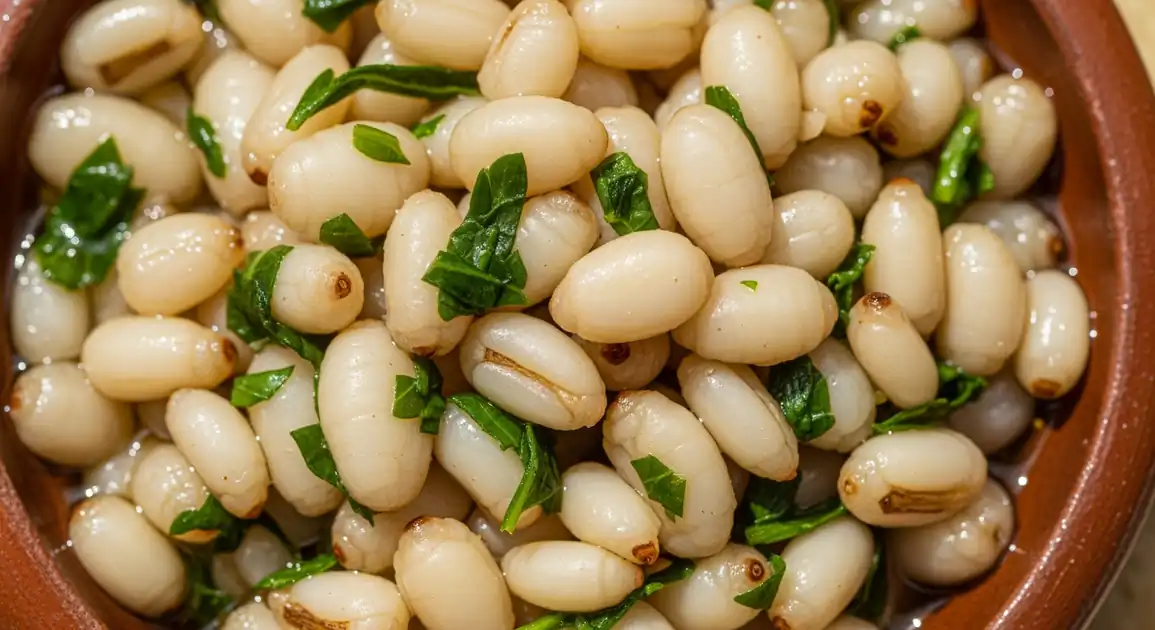Escamoles (Ant Larvae/Pupae)
Escamoles

Description
Mexico City is one of the prime locations to experience Escamoles, especially in restaurants celebrating traditional and pre-Hispanic Mexican cuisine. During the spring season (Feb-May), many upscale and specialized restaurants in areas like Polanco, Condesa, Roma, and the Centro Histórico will feature them on their menus. Markets like San Juan also offer them.
Dietary Information
Serving information
Serving style
Usually served sautéed with epazote in a small dish with corn tortillas on the side. Can also appear in tacos, mixed with guacamole, or occasionally in other preparations at inventive restaurants.
Quick facts
Restaurants: Lunch (approx. 1 PM - 5 PM), Dinner (approx. 7 PM - 11 PM). Mercado de San Juan: Generally 9 AM - 5 PM.
Safety Tips
What to Look For
-
Served in a reputable restaurant known for handling seasonal/pre-Hispanic ingredients
Ensures better sourcing, handling, and freshness knowledge for this perishable delicacy.
-
Creamy white, plump appearance (cooked)
Fresh, properly cooked escamoles should look moist and have a pale, appealing color. Avoid grey or discolored ones.
-
Dish is served hot and smells fresh/nutty
Temperature indicates recent preparation. Off-smells are a clear warning sign of spoilage.
-
Clear information about seasonality (ordering during Spring: Feb-May)
Authentic, fresh escamoles are primarily available during this window. Off-season offerings are likely frozen or preserved, affecting quality.
What to avoid
-
Suspiciously cheap escamoles
Harvesting is difficult, making them expensive. Very low prices might indicate poor quality, spoilage, or adulteration.
-
Escamoles served lukewarm or cold
Indicates they were not freshly prepared, increasing spoilage risk.
-
Dull, grey, brownish, or dried-out appearance
Strong indicators of poor quality or spoilage.
-
Vendors or restaurants with questionable hygiene standards
General cleanliness is crucial, especially for delicate ingredients.
-
Ordering if you have a known shellfish or insect allergy without caution
Potential for cross-reactivity exists. Consult with staff or start with a minimal portion.
Price information
Price range
Budget tips
- Prices reflect their status as a delicacy; expect costs at the higher end, especially in top restaurants.
- Sharing an appetizer portion is common.
- Lunch menus might occasionally offer slightly better pricing than dinner menus.
- Market purchase (raw) is cheaper but requires knowledge for selection and preparation.
Value indicators
- Served at well-regarded restaurants (e.g., Pujol, Quintonil, Nicos, El Cardenal often have seasonal dishes).
- Plump, uniformly creamy-white larvae.
- Clear, fresh smell.
- Preparation highlights the ingredient (not masked by heavy sauces).
Where to Find This Dish
Polanco / Condesa / Roma
Areas with a high concentration of upscale and trendy restaurants, many of which feature seasonal Mexican ingredients like escamoles.
Lincoln Park (Polanco), Parque México (Condesa), Plaza Rio de Janeiro (Roma)
Lunch, Dinner (during season)
Centro Histórico
Home to long-standing traditional restaurants (e.g., El Cardenal, Hostería de Santo Domingo) that often serve escamoles seasonally.
Zócalo, Palacio de Bellas Artes
Lunch, Dinner (during season)
Mercado de San Juan
Famous market for exotic meats, insects, and produce. Escamoles can often be found here (raw or cooked) during the season. Requires careful selection.
Ernesto Pugibet Street
Morning/Mid-day (for market purchase, during season)
Vendor Tips
- Make reservations, especially at popular restaurants during peak season, and inquire about escamoles availability when booking.
- Don't hesitate to ask the staff about the origin (state like Hidalgo or Tlaxcala is common) and freshness.
- At Mercado de San Juan, compare vendors and look for the freshest appearance (bright, creamy white) if buying raw. Cook thoroughly.
How to Order
Regional Variations
-
Escamoles with Bone Marrow (Tuétano)
(Escamoles con Tuétano)
A richer preparation sometimes found in modern restaurants, pairing sautéed escamoles with roasted bone marrow.
-
Mixed Insect Appetizer
(Botana de Insectos)
Some restaurants offer platters featuring escamoles alongside other edible insects like chapulines (grasshoppers) or gusanos de maguey (maguey worms).
Cultural context
History
Consumed since pre-Hispanic times, escamoles were a valuable source of protein for Aztec and other indigenous cultures in Mesoamerica. Their collection, often from the base of maguey or nopal plants, was and remains a labor-intensive process. Today, they are considered a gourmet ingredient, connecting modern Mexican cuisine with its ancient roots.
Local significance
In Mexico City, eating escamoles is often seen as a sophisticated culinary experience, connecting diners to ancient traditions and biodiversity. It's a highlight of seasonal menus.
Eating customs
- Typically the first course of a special meal.
- Paired with light alcoholic beverages like tequila, mezcal, or dry white wine.
- Enjoyed slowly to appreciate the flavor and texture.